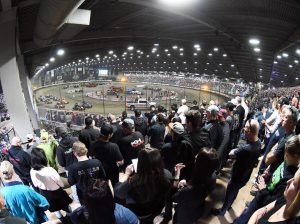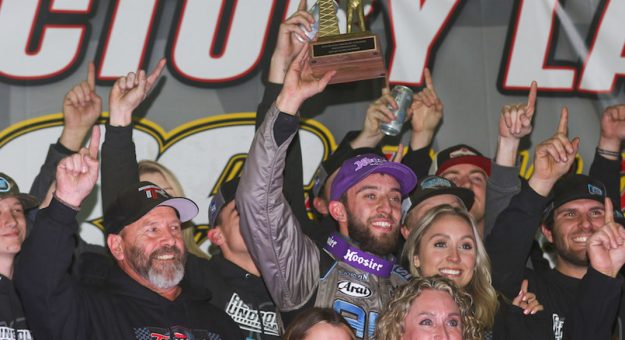Indoor midget racing dates back to the 1930s and for the most part has served as a fun wintertime diversion for fans and participants. Over time, high-profile events have been launched like the famed Astro Grand Prix at the Houston Astrodome, and similar promotions followed at the Seattle Kingdome, the Hoosier Dome and the Pontiac (Mich.) Silverdome.
While these races had a moment in the sun, they all pale in comparison to the widespread interest generated by the Lucas Oil Chili Bowl Nationals.
So many positive forces conspired to help this unique event prosper. Tulsa, Okla., is in the heartland, offering relatively easy access to all. The building itself is one of the most unique of its kind. Most important of all, the expanse of the facility allows for a proper race track to be constructed.

Then there is the matter of the trophy. Whoever decided to replicate the now iconic statue that stands outside the venue should be congratulated for their foresight. The winner’s hardware may not quite enjoy the prestige of the Indianapolis 500’s Borg-Warner Trophy but grabbing the Golden Driller on a Saturday night in January is high on the bucket list of many racers.
Emmett Hahn and the late Lanny Edwards saw the potential of their joint venture, but whether they envisioned just how big it has become is difficult to imagine. The entries seemingly climb every year and the former two-day happening now comprises six nights. The entire spectacle tends to befuddle the mind of many when they experience it for the first time.
While it took a few years to catch on, there is no question the Chili Bowl is one of the crown jewels of short-track racing. Where it stacks up among other premier events can produce a fierce debate. Within midget racing only the Turkey Night Grand Prix, by virtue of its history, may garner more prestige.
It seems each year this race enters the consciousness of more casual fans. It could be argued that this recognition is fueled by appearances by drivers who have name recognition.
Which brings us to this year. Grumblings about the payout for the Chili Bowl have been present for years. The argument forwarded is that while profits have surely skyrocketed, the purse has remained stagnant. This discussion moved to a new level when two-time winner Kyle Larson indicated he would not attend this year’s race and tied his decision to this very issue. It is also reported, but not confirmed, that Christopher Bell will be absent.
While Tanner Thorson masterfully crashed the party last year, there is no debate that the Larson-Bell duel has been highly anticipated for more than a half-decade. There is little doubt many fans will miss this on-track rivalry.
This entire kerfuffle has many layers. Logic suggests the Chili Bowl is a highly profitable event. Whatever level of fiscal success it enjoys is the result of gumption, good fortune and a ton of hard work. It is also an expensive production that has some unique costs faced by few motorsports ventures.
These costs include help to teams and drivers beyond the posted purse. Some of that help may have lured a big name or two, and some has been offered to help a fledgling racer and team. So what is the ultimate bottom line? Only a select few know. Is it truly the business of outsiders to know? Of course not.
There is also one fundamental aspect to this debate. Participation in the Chili Bowl is a voluntary activity. It is a one-off event with its own rulebook and there are no series points at stake. What compounds this entire conversation are realities that expand beyond the Chili Bowl.
For most, midget racing may have the worst return on investment of any motorsport discipline. Add to this basic template the realities of a Chili Bowl effort. It is a multi-night event with all the typical costs of racing plus food and lodging. It is an expensive endeavor.
Even if a rational cost-benefit analysis suggests that keeping a car in the shop is the best option, history shows that when they build this track they come — in droves.
The truth is some make the trip and max out the credit card knowing they have scant chance to make Saturday’s C main. It is a choice that causes some to shake their heads. For others participating in this event is good business, particularly when there are waves of drivers who will gladly pay for a chance to participate.
